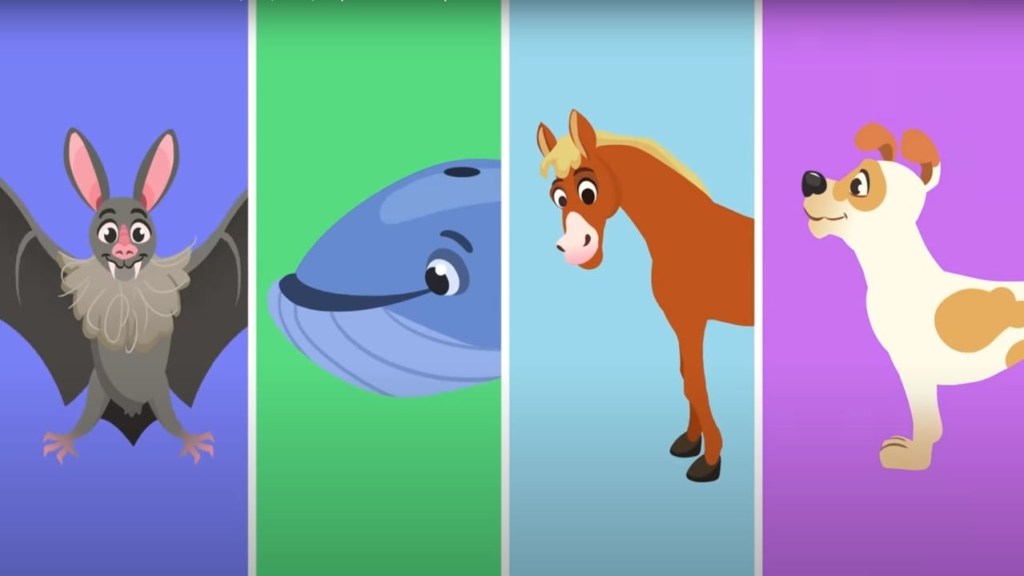Vertebrate animals are all those that have a skull, tail, and a spine or vertebral column that divides their body into two equal parts. Its skeleton is internal and can be bony or cartilaginous.
Some 60 thousand species belong to the group of vertebrates, including extinct species.
Regarding its taxonomic category, this type of animal belongs to the subphylum Vertebrata, one of the three groups of the phylum Chordata (chordates). During some period of their life cycle, these animals possess a notochord, a dorsal nerve cord, pharyngeal slits, and tail.
Origin of vertebrate animals
It is estimated that vertebrates appeared at the beginning of the Cambrian period, about 530 million years ago. Specifically during a period called the Cambrian explosion. This period is characterized by the sudden appearance of complex multicellular organisms.
Findings from older vertebrates, such as Haikouichthys and Myllokunmingia, suggest that they are a group of animals that originated in freshwater. However, later they adapted to other types of environments. These adaptations enabled them to have a presence not only in water, but also on land and in the air.
Types of vertebrates
According to conventional classification vertebrates grouped into seven classes:
- Agnatha (jawless fishes)
- Chondrichthyes (cartilaginous fishes)
- Osteichthyes (bony fishes)
- Amphibia (amphibians)
- Reptilia (reptiles)
- Aves (birds)
- Mammalia (mammals)
However, vertebrates can also be classified into 4 large groups:
1. Osteichthyes (bony vertebrates)
To this group belong all the fish that have a bony internal skeleton, that is, made of bones. Although they may have cartilaginous structures, these constitute a small part. They generally have a terminal mouth with articulated dermal bones, from where the teeth emerge. Once they lose their teeth, they cannot replace them.
The giant grouper and the scorpion fish are two examples of osteichthyes fish.
2. Gnathostomata (vertebrates with jaws)
These are vertebrate fish with cartilaginous internal skeleton, for the most part. Their teeth are not fused with the jaw, and they are able to replace them as they wear out.
Chimaeras, rays (Batoidea), giant oceanic manta ray, and sharks belong to this group.
3. Agnatha or Cephalaspidomorphi (lampreys and other jaw less fish)
This is a type of vertebrate fish that lacks a jaw. They look like eels and cannot process food in the same way as jawed fish. This is why they are hematophagous (they feed on blood) or necrophages (they feed on corpses).
Lampreys and hagfish are representatives of agnatha vertebrates.
4. Tetrapoda (four-limbed vertebrates)
Mammals, birds, reptiles and amphibians belong to this group.
Mammals
They are characterized by the presence of hair, hands, feet or legs. They also have a jaw with dental bone and mammary glands.
The lion, the dolphin, the horse, the dog and the human being are some examples of mammalian vertebrates.
Birds
They are vertebrates characterized by the presence of feathers. They are supported by their hind limbs, while the forelimbs evolved into wings. However, not all species of birds are capable of flight.
The eagle, the parrot, the hummingbird, the hawk and the pelican are some well-known birds.
Amphibians
This type of vertebrate animal is characterized by significant muscular development of its limbs, which allows them to move through jumps or swimming.
The toad, the salamander and the newt are vertebrates of the amphibian group.
Reptiles
They have a resistant skin, covered by keratin scales. Their limbs are very short or nonexistent (as in snakes), so they have to crawl around. They are also capable of laying shell eggs.
The turtle, the iguana and the crocodile are some of the best known reptiles.
Types of vertebrate animals according to their body temperature
Vertebrates can also be classified according to their ability to regulate internal temperature.
Endothermic vertebrates
Also known as warm-blooded vertebrates, they are those capable of maintaining a constant temperature regardless of external factors. In general, their temperature range is between 34ºC and 38ºC. Mammals and birds are in this group.
Ectothermic vertebrates
Also called cold-blooded vertebrates, they are all those animals that can regulate their body temperature based on the external temperature. Reptiles, amphibians, and fish belong to this group.
RELATED POSTS:
